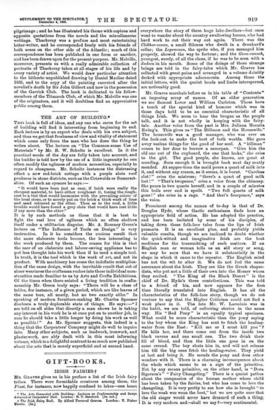THE ART OF BUILDING. *
Tana book is full of ideas, and any one who cares for the art of building will find it interesting from beginning to end. Each lecture is by an expert who deals with his own subject, and thus we get that freshness of view and vitality of statement which come only from the man who has done the thing he writes about. The lecture on " The Common-sense Use of Materials" by Mr. R. W. Schultz is excellent. In it the practical needs of the day are fully taken into account, and the builder is told how by the use of a little ingenuity be can often modify the ugliness of modern necessities, especially in regard to cheapness. Mr. Schultz instances the distressing
effect a new red-brick cottage with a purple slate roof produces in stone districts, such as the Cotswolds or Somerset- obi re. Of such an eyesore he says:— "It would have been just as easy, if brick were really the cheapest material, to have either roughcast it, toning the rough- cast to a tint that would harmonise with the prevailing colour of the local stone, or to merely put on the brick a thick wash of lime and sand coloured as the other. Then as to the roof, a little trouble would have found a grey slate that would have coat little if any more than the other."
It is by such methods as these that it is best to
fight the real love of ugliness which so often shelters itself under a utilitarian disguise. Mr. A. Romney Green's lecture on "The Influence of Tools on Design" is very instructive. In it he considers the curious result that the more elaborate tools become, the less interesting is the work produced by them. The reason for this is that the user of an elaborate and labour-saving appliance has to put leas thought into his work than if he used a simple tool. In truth, it is the tool which is the work of art, and not its product. With machinery has come the indefinite multiplica- tion of the same design, with the inevitable result that out of sheer weariness the craftsman rushes into those individual mon- strosities made familiar to us by Arts and Crafts Exhibitions. Of the times when there existed a living tradition in crafts- manship Mr. Green truly says : "There will be a class of tables, for instance, of a given period, which are like leaves of
the same tree, all nearly, but no two exactly alike." In speaking of modern furniture-making Mr. Charles Spooner discloses a truly deplorable state of things. He says :—" I am told on all sides that directly a man shows he is taking
any interest in his work he is at once put on to another job, in case he should take a little longer by doing his work as well as possible !" As Mr. Spooner suggests, this indeed is a thing that the Carpenters' Company might do well to inquire into. Many other subjects, such as leadwork, ironwork, and plasterwork, are ably dealt with in this most informing volume, which is a delightful contrast to so much now published about the arts that is merely superficial and at second hand.






































































 Previous page
Previous page